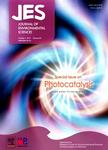版权所有:内蒙古大学图书馆 技术提供:维普资讯• 智图
内蒙古自治区呼和浩特市赛罕区大学西街235号 邮编: 010021

作者机构:Department of Chemistry Analytical and Testing Center Capital Normal University State Key Laboratory of Severe Weather & Key Laboratory for Atmospheric Chemistry of China Meteorology Administration Chinese Academy of Meteorological Sciences State Key Laboratory of Atmospheric Boundary Layer Physics and Atmospheric Chemistry Institute of Atmospheric Physics Chinese Academy of Sciences Center for Excellence in Urban Atmospheric Environment Institute of Urban Environment Chinese Academy of Sciences Jinan Environmental Monitoring Center
出 版 物:《Journal of Environmental Sciences》 (环境科学学报(英文版))
年 卷 期:2019年第31卷第6期
页 面:107-115页
核心收录:
学科分类:07[理学] 070602[理学-大气物理学与大气环境] 0706[理学-大气科学]
基 金:supported by the National Key R&D Program of China (No. 2017YFC0210000) the Beijing Municipal Science and Technology Project (No. ZL171100000617002) the Scientific Research Project of the Beijing Education Commission (No. KM201510028007) LAC/CMA (2017A01) the National Natural Science Foundation of China (Nos.41471306, 41505133, 41705113, 41877312)
主 题:Seasonal variations Biogenic secondary organic aerosols Biomass burning Anthropogenic contributions
摘 要:Secondary organic aerosols(SOAs) are an important component of particulates, but whether biogenic SOAs(BSOAs) or anthropogenic SOAs(ASOAs) are the dominant contributors to haze pollution remains poorly characterized. In this study, particulate samples were collected from September 2014 to August 2015 at an urban site in Jinan, which is the capital of Shandong Province and a typical city in the North China Plain. The PM2.5 samples were analyzed for BSOA(isoprene(SOAI) and monoterpenes(SOAM)) and ASOA(aromatic(SOAA)) tracers. The concentrations of the SOAAtracer(1.1 ± 1.0 ng/m3) were lowest, and those of SOAItracers(41.8 ± 86.2 ng/m3) were highest, with the concentrations of SOAMtracers(19.4 ± 9.9 ng/m3) being intermediate. The SOAItracers were more abundant in the summer and less abundant in the winter. Both SOAIand SOAMincreased with increasing ozone level but decreased with increasing NOx level. Correlation analysis revealed a good correlation between 2,3-dihydroxy-4-oxopentanoic acid and levoglucosan levels in three seasons. These results suggested that biomass burning activities occurring in the NCP can enhance the emissions of aromatics and should be controlled, especially in the autumn and winter. SOA tracers were classified according to pollution degree, and the results showed that as pollution increases, the contributions of SOAAincrease. These results indicate that reducing anthropogenic emissions is necessary to prevent SOA pollution, especially during heavy pollution episodes.